Islas Canarias
Author: Leo Colovini
Publisher: Clementoni
Year: 2009
review by

| x |
|
|
|
|
|
|
|
|
|
|
|
|
|
|
|
|
|
|
|
|
|
|
|
|
|
|
|
|
|
|
|
|
|
|
|
|
|
|
|
|
|
|
|
|
|
|
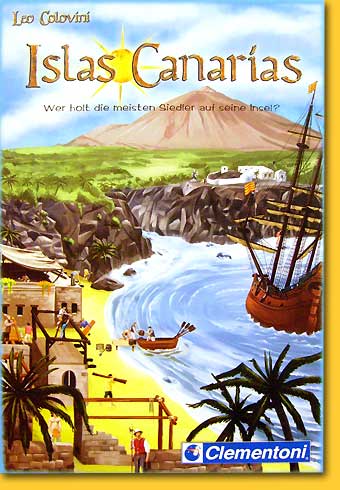 |
Most visitors of the Canarian Islands are not much of adventurers; a week on the beach in the sun is what they want, and thus it is a come and go of flying containers from various European countries dumping their loads nearby the beaches where the crowd is a shining beacon for the little daredevils from Africa in their rickety boats who use the islands as gateway to Europe. But all was different in the old days! According to the notice from the publisher adventurers and sailors alike, apparently two different categories, were the ones from Spain to search for a new home on the islands. Envy is of all times, so on the way there already was the usual bragging of furnishing the house with a Bulthaup kitchen; one thing leads to another and once ashore, each on their own island, they quickly built not only houses, but also palaces that would encourage newcomers to settle on their island, and not on that of the neighbour’s with that IKEA furnishing. The laborious refining and furnishing ultimately is done for the most points and the enclosing victory. |
|
| x |
|
|
|
|
|
|
|
|
|
|
|
|
|
|
|
|
|
|
|
|
|
|
|
|
|
|
|
|
|
|
|
|
|
|
|
|
|
|
|
|
|
|
|
|
|
|
| At the start of the game players each choose an island board; these each are different in geography but all offer space for twelve houses, palaces or cities. Players start with five hand cards; in a turn one is played to build a house on the island. The card shows which colour house may be built, and where. The building regulations are worked in order of priority: first the first condition is checked; the condition either states a type of terrain or a house of a specific colour that the house must be built next. The possible types of terrain are sea, mountain, river, farmland, road or village. If it is not possible to build a house under the first condition, then the second condition is checked, and so on, until a condition can be met and the house can be placed. |
|
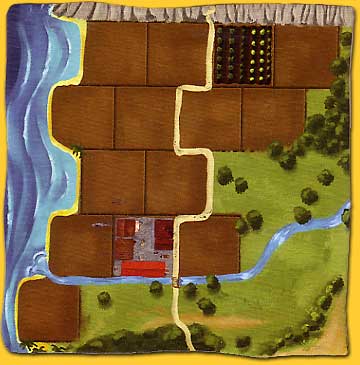 |
|
| x |
|
|
|
|
|
|
|
|
|
|
|
|
|
|
|
|
|
|
|
|
|
|
|
|
|
|
|
|
|
|
|
|
|
|
|
|
|
|
|
|
|
|
|
|
|
|
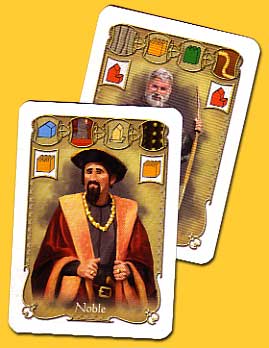 |
|
As a second and last action in his turn a player places a card face down in the centre of the table to a virtual arriving ship; at the beginning of the game a first card already was drawn from the deck for it. When each player has taken his turn, the cards in the centre are shuffled and turned face up one by one. Now each card shows the condition for a new arriving settler on an island, but on which island will he build his house? The card shows the terrain or colour of house it has to be built adjacent to, in fact nothing new but now all players check this condition. The player who has the most free space next to the condition - e.g. most free space adjacent to all green houses on his island - may welcome the virtual adventurer and place a house on any of the conditional spaces on his island. If more players have an equal amount of spaces adjacent to their terrain or houses, the next condition is checked. The last ship card in the centre of the table is not played but transferred to the next round. |
|
| x |
|
|
|
|
|
|
|
|
|
|
|
|
|
|
|
|
|
|
|
|
|
|
|
|
|
|
|
|
|
|
|
|
|
|
|
|
|
|
|
|
|
|
|
|
|
|
If players have no or just one card in their hands, they are obliged to draw three cards from the deck and are not allowed to build. Drawing cards is allowed any turn instead of building.
Because each house is only worth one point, a palace three, and a town five points, a player will try to quickly upgrade his buldings. Two houses may at any time in a turn be transferred into a palace of the same colour; three houses to a town. Palaces also earn the privilege card of the same colour.
These privileges bring things such as drawing four instead of three cards; neglecting the building rules or transferring two different coloured houses into a palace in any of the two colours. |
|
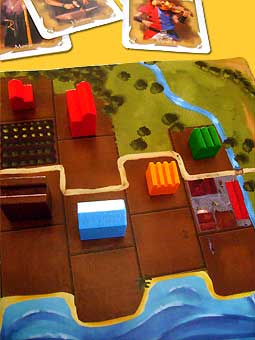 |
|
| x |
|
|
|
|
|
|
|
|
|
|
|
|
|
|
|
|
|
|
|
|
|
|
|
|
|
|
|
|
|
|
|
|
|
|
|
|
|
|
|
|
|
|
|
|
|
|
And then there is the pirates! In the card deck are six pirates in each of the six colours. These cards cannot be used to build, so the only way to play them is to place them in the centre of the table. When such a card is revealed, the player with the privilege in that colour has to remove a house in any colour from his island. When the privilege is not yet claimed, the pirate affects the player who has the most points in houses, palaces and towns for that colour.
At the end of a round players count their points; if a player has reached or exceeded 19 points a final round is played after which the player with the most points has won. |
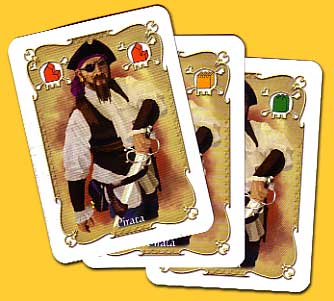 |
|
| x |
|
|
|
|
|
|
|
|
|
|
|
|
|
|
|
|
|
|
|
|
|
|
|
|
|
|
|
|
|
|
|
|
|
|
|
|
|
|
|
|
|
|
|
|
|
|
| x |
|
|
|
|
|
|
|
|
|
|
|
|
|
|
|
|
|
|
|
|
|
|
|
|
|
|
|
|
|
|
|
|
|
|
|
|
|
|
|
|
|
|
|
|
|
|
| x |
|
|
|
|
|
|
|
|
|
|
|
|
|
|
|
|
|
|
|
|
|
|
|
|
|
|
|
|
|
|
|
|
|
|
|
|
|
|
|
|
|
|
|
|
|
|
 |
|
|
|
|
|
|
|
|
|
|
|
|
|
|
|
|
|
|
|
|
|
|
|
|
|
|
|
|
|
|
|
|
|
|
|
|
|
|
|
|
|
|
| When building, a player has total control by playing the wanted card. This is somewhat different when the card for the ship is revealed. Of course a player hopes that the card he played in the centre will enable him to build a second time this round, for instance because he has the most free spaces next to the mountain, the first condition on the card he played. But conditions of other players may change: when an other player has built a palace, there is an additional free space on that player’s board that may give the house to that player instead, or the changed situation may force it to look at the second condition on the card - where it is already difficult enough to try to memorise all possible changes and conditions, the card may as well go unplayed into the next round where the player will have forgotten half of it because he has to deal with a new situation. In the worst case it comes down to guessing; the card even may come as a total surprise after two or three rounds. |
|
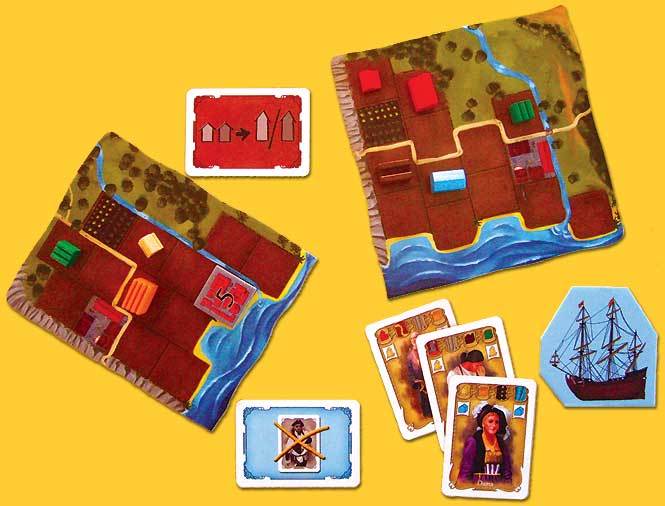 |
| x |
|
|
|
|
|
|
|
|
|
|
|
|
|
|
|
|
|
|
|
|
|
|
|
|
|
|
|
|
|
|
|
|
|
|
|
|
|
|
|
|
|
|
|
|
|
|
All island boards are different; one has more spaces next to the sea, another to the mountain, and a third to the river. This way the ship cards will not cause a tie for which player may build the house, a possibility further decreased by the second, third and fourth condition.
As for the illustrations: is the illustrator a handicapped person or something? I mean, he did a decent job on the box cover - for a mouth painter. Wow, what an ugly illustration! |
|
| x |
|
|
|
|
|
|
|
|
|
|
|
|
|
|
|
|
|
|
|
|
|
|
|
|
|
|
|
|
|
|
|
|
|
|
|
|
|
|
|
|
|
|
|
|
|
|
‘Islas Canarias’ has a nice mechanism and it plays quite nice, but it does not have the wow factor that makes you want to play it over and over again. Whenever the game is tactical or not, and if this really matters, is of no importance nor a problem. The game just is not that different from other games. It does not irritate, and even is a bit righteous; it is nice to have it here, but if it does not get played it is not really missed either.
As with this long forgotten but vaguely known lad who with a school reunion joins the terribly-having-fun-and-known-to-any-other group: ‘Say, no, were you also in our class? Ehr, well, nice to have you here!’.
But in fact if you wouldn't have shown up, we would be having just as much fun...
© 2009 Richard van Vugt
Islas Canarias, Leo Colovini, Clementoni, 2009 - 2 to 5 players, 10 years and up, approx. 45 minutes
|
|
  |
|
|
|
|
|
|
|
|
|
|
|
|
|
|
|
|
|
|
|
|
|
|
|
|
|
|
|
|
|
|
|
|
|
|
|
|
|
|
|
|
|
|
  |
|
|
|
|
|
|
|
|
|
|
|
|
|
|
|
|
|
|
|
|
|
|
|
|
|
|
|
|
|
|
|
|
|
|
|
|
|
|
|
|
|
|
  |
|
|
|
|
|
|
|
|
|
|
|
|
|
|
|
|
|
|
|
|
|
|
|
|
|
|
|
|
|
|
|
|
|
|
|
|
|
|
|
|
|
|
  |
|
|
|
|
|
|
|
|
|
|
|
|
|
|
|
|
|
|
|
|
|
|
|
|
|
|
|
|
|
|
|
|
|
|
|
|
|
|
|
|
|
|
| x |
|
|
|
|
|
|
|
|
|
|
|
|
|
|
|
|
|
|
|
|
|
|
|
|
|
|
|
|
|
|
|
|
|
|
|
|
|
|
|
|
|
|
|
|
|
|
| x |
|
|
|
|
|
|
|
|
|
|
|
|
|
|
|
|
|
|
|
|
|
|
|
|
|
|
|
|
|
|
|
|
|
|
|
|
|
|
|
|
|
|
|
|
|
|
 |
|
|
|
|
|
|
|
|
|
|
|
|
|
|
|
|
|
|
|
|
|
|
|
|
|
|
|
|
|
|
|
|
|
|
|
|
|
|
|
|
|
|
 |
|
|
|
|
|
|
|
|
|
|
|
|
|
|
|
|
|
|
|
|
|
|
|
|
|
|
|
|
|
|
|
|
|
|
|
|
|
|
|
|
|
|
| x |
|
|
|
|
|
|
|
|
|
|
|
|
|
|
|
|
|
|
|
|
|
|
|
|
|
|
|
|
|
|
|
|
|
|
|
|
|
|
|
|
|
|
|
|
|
|
 |
|
|
|
|
|
|
|
|
|
|
|
|
|
|
|
|
|
|
|
|
|
|
|
|
|
|
|
|
|
|
|
|
|
|
 |
|
|
|
|
|
|
|
|
|
|
|
|
|
|
|
|
|
|
|
|
|
|
|
|
|
|
|
|
|
|
|
|
|
|
|
|